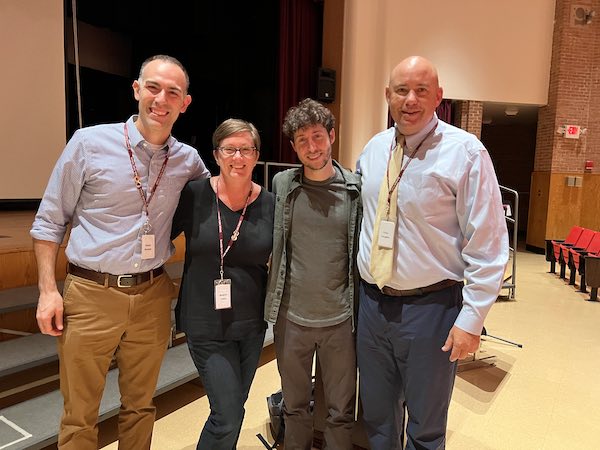Navigating Use of Social Media - For Kids and Parents Too
- Category: Schools
- Published: Tuesday, 17 October 2023 14:20
- Joanne Wallenstein
 Daniel Boniello, Meghan Lahey, Max Stossel and Chris CoughlinNot many social media entrepreneurs leave the tech world to teach parents and kids how to manage their use of social media. But poet, storyteller, filmmaker and educator Max Stossel has done just that. Stossel ran social for multinational brands, and later worked for a social media company where he designed some of the same notification structures to distract people that he now criticizes.
Daniel Boniello, Meghan Lahey, Max Stossel and Chris CoughlinNot many social media entrepreneurs leave the tech world to teach parents and kids how to manage their use of social media. But poet, storyteller, filmmaker and educator Max Stossel has done just that. Stossel ran social for multinational brands, and later worked for a social media company where he designed some of the same notification structures to distract people that he now criticizes.
Stossel is the founder of Social Awakening, an organization dedicated to helping young adults and parents survive and thrive in the complicated digital world. Max is also the Youth & Education Advisor for the Center for Humane Technology, an organization of former tech insiders dedicated to realigning technology with humanity’s best interests.
So Scarsdale was fortunate to have him at the middle school on October 16 when he presented his insights to seventh and eighth graders during the day and then held a session for parents that evening.
Opening his talk, he asked, “How can something so wonderful as technology be causing so much stress and anxiety?”
He went on to explain that the apps on your cell phone are always on and constantly feeding you updates and notifications. In fact they are built to spur maximum user engagement, causing many to get addicted to the use of their phones.
And using these apps does not always make you feel good. Stossel displayed a chart of apps that improve your day, like utilities, fitness apps and audio books and those that make people feel angry and drained including gaming apps and social media apps like Streaks on Snapchat.
Streaks, which is a messaging service, measures the users number of friends and counts your streaks. It makes users competitive about their number of friends. Features like “Snap Map” lets your friends see where you are and leaves those who are elsewhere feeling left out and alienated. He showed the feeds that teens are receiving from Snapchat – some bordering on pornography and many inappropriate images. He said, “If social media were a movie it would be rated NC-17.”
About Tik Tok Stossel said, “It’s run by a Chinese company and has a significant impact on what kids do. But in China they don’t let kids use Tik Tok.”
He pointed out the disinformation being spread by YouTube videos which are widely watched. In fact the average time of a visit to You Tube in an hour. He said, “90% of the videos on YouTube will tell you that the world is flat. About the content he said, “You Tube curates what it sends you based on algorithms. It sends you to the most extreme version of whatever you believe.”
Dispelling some myths about the use of technology he said, “There is no such thing as visual multitasking.” For kids in school the people whose phone is in another room do five points better on tests than those with their phone nearby.
About social interactions, he said, “People use phones as a safety blanket to run away from each other and themselves. He said, “I am a big fan of “away for the day “programs where phones are put away during school hours.” He advised parents to “Create more spaces that are not dominated by social media and phones.”
About mental health he said, “The decline in free play for kids is leading to a decline in mental health. Let kids be kids.”
Stossel is a fan of the “Wait Until 8th” movement which encourages parents to wait until eighth grade before buying their child a smart phone. For safety and communication with younger children he advised purchasing a Gabb wireless phone or a Pinwheel kids’ phone, which are devices that allow you to communicate with your child while controlling their access to the web and the apps.
If your child asks for a new app, Stossel advises parents to download it on their own phone first and use it for a week. See what happens before providing it to your child.
Another strategy for decreasing the impact of technology at home is to have “device free” dinners where no phones or screens are permitted. Devices can also be banned from bedrooms and can all be stored at a communal charging station in the kitchen or living room at night. That way kids don’t have the option of staying up late with their phones and being kept awake by the blue lights.
He said that many people use their phones as alarm clocks – and wake up to their emails and messages. Why not use an alarm clock instead – and wake up with your own thoughts rather than messaging that is programmed for you.
Stossel also advocates asking your kids to help monitor their own screentime and use of social media. If controls are needed he suggested that parents confer with their children to come up with an acceptable plan. He said most kids are pretty reasonable.
See a video of one of his presentations here:







